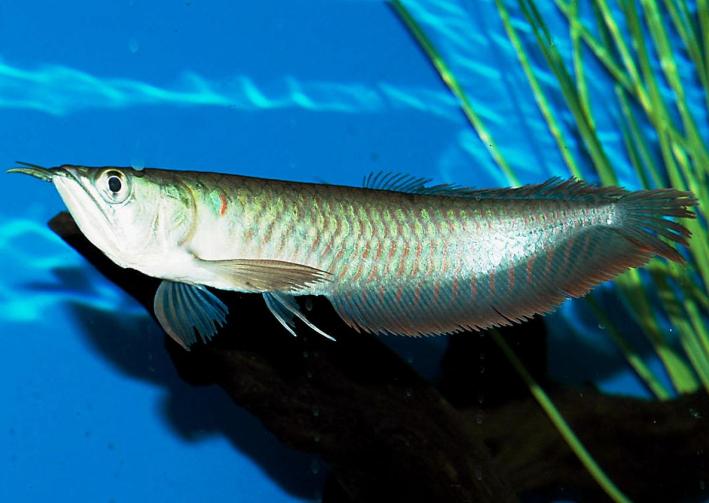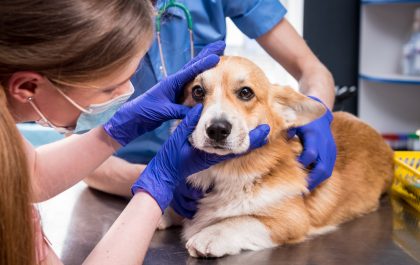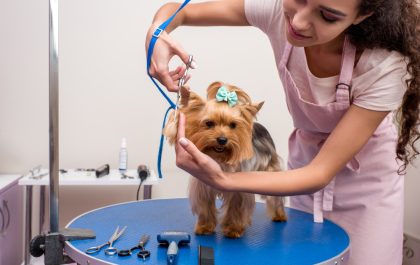Size: Up to 90cm, 3ft
Lifespan: Up to 20 years
Temperament: Generally peaceful and calm
Care Level: Moderate to High
Diet: Omnivore, small live fish, frozen foods, pellets, vegetables
Tank Size: Minimum 180L, 48gal
Water Parameters: pH 6.5-8.0, Temperature 24-29’C
Tank Mates: Other peaceful fish, no small fish
Minimum Tank Volume: 180L, 48gal
Social Behaviour: Generally solitary, may school in large tanks
Are you considering an Arowana for a pet? If so, you have come to the right place! Arowanas are a popular fish species in Australia, and are often kept as pets. This article will provide you with all the information you need to know about Arowanas as pets, from the different types of Arowanas to the best environment for them to thrive. Read on to learn more about these fascinating creatures and how to give them the best possible home.
Introduction to Arowanas as Pets
Arowanas are a fascinating species of fish that can make an excellent pet for the right owner. Native to the rivers of South America, Australia, and Southeast Asia, these fish have become popular in the aquarium hobby due to their unique appearance and interesting behaviours.
Arowanas are an active species, and they require a large tank ‘ at least 55 gallons ‘ to provide them with enough space to swim. They are also a predatory species, so they should not be kept with smaller fish or invertebrates. Arowanas are also quite sensitive to water quality, so regular water changes and maintenance of the tank are essential for their health. They are also sensitive to sudden changes in the environment, so it is important to acclimate them slowly when introducing them to a new tank. With the right care, however, Arowanas can live for up to 10 years in captivity.
Types of Arowanas
Arowanas are a popular choice of pet for many aquarists in Australia. There are several types of Arowanas available, each with their own unique characteristics.
The most common type of Arowana is the Asian Arowana, also known as the Dragon Fish. This species is native to Southeast Asia and is the most popular type of Arowana for aquarists in Australia. The Asian Arowana is an impressive fish, with a long, slender body and bright scales. It is known for its intelligence and active behaviour, making it an ideal pet for those looking for an interactive fish.
The Silver Arowana is another popular type of Arowana. This species is native to South America and is known for its silver colouration and large size. Silver Arowanas are usually quite peaceful and can be kept in a community tank with other fish, as long as they are of a similar size. They are also known for their intelligence and active behaviour, making them a great choice for those looking for a lively pet.
Finally, the Black Arowana is a rare species native to the Amazon River. This species is known for its striking black colouration and is highly sought after by aquarists. Black Arowanas are usually quite peaceful and can be
Caring for Arowanas
Arowanas are an increasingly popular pet choice for aquarists in Australia. With their beautiful scales and long lifespans, they can make a great addition to any home. However, caring for an Arowana is not for the faint of heart, as they require a great deal of attention and specialised care.
The first step in caring for an Arowana is to ensure that their tank is large enough. Arowanas can grow to be quite large, so it is important that they have enough space to move around. Arowanas also need clean water, and it is important to check the water quality regularly. The tank should also be equipped with a filtration system to keep the water clean and free of toxins. Additionally, Arowanas need to be fed a balanced diet of high-quality fish food. It is also important to provide them with plenty of hiding places and decorations to keep them comfortable.
Finally, it is important to keep an eye on the Arowana’s health. Regular water changes and monitoring of the water quality are essential, as well as checking for signs of disease. If any health issues arise, it is important to seek professional advice from a vet or aquarist. With the right care and attention, Arowanas can make a wonderful
Feeding Arowanas
Arowanas are a popular choice of pet for many aquarists, due to their striking colouration and impressive size. As with any pet, it is important to ensure that your Arowana is receiving the correct nutrition to keep it healthy and happy.
Feeding your Arowana is relatively straightforward. They are omnivorous, so a balanced diet of both plant and animal matter is recommended. Arowanas are known to be quite opportunistic feeders, so it is important to ensure that they are not overfed. A variety of foods such as frozen shrimp, earthworms, and bloodworms can be offered, as well as a range of vegetables such as spinach, zucchini, and peas. It is also important to ensure that the food is of a suitable size for your Arowana to consume. As a general rule, the food should not be larger than the distance between the eyes of the Arowana. For larger Arowanas, it is recommended to feed them two to three times per week.
Tank Set-Up for Arowanas
Arowanas are an increasingly popular choice of pet for aquarists around the world. They are a large and attractive fish that can bring a splash of colour to any home aquarium. When it comes to setting up a tank for an arowana, there are a few important factors to consider.
Firstly, the size of the tank should be appropriate for the species of arowana you are keeping. Arowanas can grow to be quite large, so it is important to provide them with enough space to swim and explore. A tank of at least 125 gallons should be used for adult arowanas, and if possible, the tank should be wider rather than taller. Secondly, the water should be kept clean and well-maintained. Arowanas are sensitive to water quality, so the tank should be equipped with a filter and regular water changes should be performed. Finally, arowanas require a high-protein diet, so make sure to provide them with a variety of live foods and frozen foods. Live foods such as crickets, earthworms, and small fish are a great source of protein for arowanas, and frozen foods like krill and shrimp should be offered regularly. With the right tank set-up, an arowana can be a rewarding and enjoyable pet for any aquarist.
Common Health Issues with Arowanas
Arowanas are a popular choice for fish enthusiasts as pets, but they can be prone to certain health issues. These can range from minor to more serious ailments. Common health issues with Arowanas include bacterial infections, fungal infections, swim bladder disorder, and fin and tail rot.
Bacterial infections are usually caused by poor water quality and can manifest in the form of red streaks on the fins or body, cloudy eyes, and ulcers. Fungal infections can cause white spots on the body, which will require treatment with an antifungal medication. Swim bladder disorder is a common ailment in Arowanas, which can cause them to swim erratically or even float upside down. Fin and tail rot is caused by poor water quality and can cause the fins and tail to become discoloured or to disintegrate. If left untreated, it can be fatal. To prevent these health issues, it is important to keep the tank clean and maintain proper water parameters.
Arowanas and Other Fish in the Tank
Arowanas are a popular fish to keep in aquariums, and many aquarists choose to keep them with other fish. When housing arowanas with other fish, it is important to ensure that the tank is large enough and that the other fish are compatible.
When choosing fish to keep with arowanas, it is important to consider the size of the tank, the size of the fish, and the temperament of the fish. Smaller fish should be avoided, as arowanas are known to be aggressive and may attack smaller fish. Additionally, fish that are too large may out-compete the arowana for food. Fish that are compatible with arowanas include other large fish such as oscars, silver dollars, and tinfoil barbs. It is also important to ensure that the other fish in the tank are not aggressive, as this could lead to fights between the fish.
Legal Considerations for Owning Arowanas
Owning an Arowana as a pet is an exciting and rewarding experience, but it also comes with certain legal considerations. In Australia, the importation of Arowanas is strictly regulated by the Department of Agriculture and Water Resources. As such, Arowanas must be purchased from a reputable breeder or supplier who is licensed to import and sell them. Additionally, it is important to check with local authorities to ensure that it is legal to own an Arowana in the state or territory in which you live.
In addition to the regulations regarding importation and ownership, there are also restrictions on the size of the Arowana that may be kept as a pet. In most cases, Arowanas must be at least 20 cm in length and be kept in a tank of at least 200 litres. Furthermore, Arowanas must not be released into the wild as this can have a detrimental effect on the local environment. It is also important to note that Arowanas must not be transported across state or territory borders without the appropriate permits. By understanding and abiding by these laws, you can ensure that you are a responsible pet owner and help protect this unique species.
Final Thoughts
Arowanas are a great choice for those looking for an interesting and interactive pet fish. With the right care and attention, they can provide years of enjoyment for their owners. Before getting an Arowana, it is important to understand their needs and legal considerations, such as the size of the tank and the type of food they should be fed. Additionally, it is important to ensure that the tank is well-maintained and the water quality is regularly monitored. With the right environment and care, Arowanas can make a wonderful addition to any home.
Arowanas as Pets FAQs
Arowanas can be aggressive towards other fish, especially those of a similar size and shape. It is best to keep them in a species-only aquarium or with other large, non-aggressive fish.
Arowanas require a bit more care than other fish species, but they can be relatively easy to care for if their needs are met.
Arowanas require a lot of care and attention, so they may not be the best choice for beginners. However, experienced fish owners can enjoy keeping them as pets.
Arowanas are legal to own in some countries, but they are considered a protected species in others. Be sure to check your local laws before purchasing an Arowana.
Arowanas are legal to own as pets in most places, but some species are protected and require a permit to own. It is important to check with local laws and regulations before purchasing an Arowana.
Arowanas can be aggressive towards other fish, so it is best to keep them alone or with larger, non-aggressive fish that can tolerate their behavior.
Arowanas are intelligent fish and can be trained to recognize their owners and perform simple tricks. However, training takes time and patience and should only be attempted by experienced fish owners.
Arowanas are known for their jumping ability and can jump out of their tanks if not properly secured with a tight-fitting lid.
Arowanas can grow up to 3 feet in length, depending on the species. They are considered a large fish and require a spacious aquarium to thrive.
To ensure the health of an Arowana, it is important to provide them with a clean environment, proper nutrition, and regular check-ups with a veterinarian.
Arowanas can live up to 20 years with proper care and maintenance.
Arowanas can be expensive, with prices ranging from a few hundred to several thousand dollars depending on the species and size.
Arowanas should be fed 2-3 times a day, with a diet consisting of live or frozen food such as shrimp, crickets, and worms.
Arowanas should be fed once or twice a day, depending on their size and age. It is important not to overfeed them to avoid health problems.
It is recommended to do a partial water change once a week, and a full tank clean every 4-6 weeks.
Arowanas can be prone to diseases such as dropsy and ich, as well as spinal deformities and swim bladder issues. Regular water changes and proper care can help prevent these issues.
Arowanas are prone to various health issues, including bacterial infections, parasitic infestations, and swim bladder disorders. Regular water changes, a healthy diet, and proper aquarium maintenance can help prevent these issues.
Some tips include maintaining a clean and well-filtered aquarium, providing a varied and nutritious diet, providing plenty of swimming space, and keeping the water temperature and pH levels consistent.
Arowanas require a large tank with plenty of space to swim, a high-quality filtration system, and a balanced diet of live or frozen food.
The most common types of Arowanas are Silver, Red, Black, and Golden.
Arowanas are known for their large scales, long bodies, and bony heads. They are also popular for their metallic coloration and impressive size.
Arowanas are carnivores and require a diet of live or frozen foods such as shrimp, crickets, and worms.
An Arowana is a type of freshwater fish that is known for its unique appearance and behavior. They are also known as “dragon fish” due to their resemblance to the mythical creature.
Arowanas prefer water temperatures between 75-82 degrees Fahrenheit.
A healthy Arowana can live up to 20 years in captivity with proper care.
Arowanas require a large aquarium with plenty of swimming space. The aquarium should be at least 6 feet long, 2 feet wide, and 2 feet deep. They also prefer a well-filtered aquarium with a strong current and plenty of hiding places.
Arowanas require large tanks that are at least 250 gallons in size. The tank should also be heavily filtered and have plenty of hiding places.
Arowanas need a large tank with plenty of swimming space and hiding places. They also need a strong filtration system and proper water conditions.
Depending on the species, Arowanas can grow up to 3 feet in length.
Arowanas require clean and well-oxygenated water with a pH between 6.5 and 7.5. They also prefer a temperature range of 75 to 85 degrees F.





